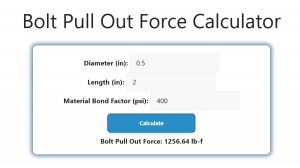About Bolt Pull Out Force Calculator (Formula)
The Bolt Pull Out Force Calculator is an essential tool for engineers, builders, and mechanics who need to determine the force required to pull a bolt out of its mating material. By calculating the pull-out force, you can design safer, more efficient structures and connections. This tool is especially useful for applications where heavy loads are involved, ensuring that bolted connections are secure and stable.
Formula
The formula for calculating bolt pull-out force is:
Fpo = D ∗ PI ∗ L ∗ MF
Where:
- Fpo = Pull-out force (in Newtons or pounds)
- D = Diameter of the bolt (in inches or millimeters)
- PI = Constant (π ≈ 3.14159)
- L = Length of engagement between the bolt and the material (in inches or millimeters)
- MF = Material strength factor, which depends on the materials of both the bolt and the mating surface
How to Use
- Input Diameter (D): Enter the diameter of the bolt in the desired unit.
- Use PI (π): Use the constant value, approximately 3.14159.
- Enter Length of Engagement (L): Input the length that the bolt is embedded in the material.
- Provide Material Factor (MF): Enter the material strength factor based on the bolt and material specifications.
- Calculate Pull-Out Force (Fpo): The calculator will compute the pull-out force based on these inputs.
Example
Suppose you have a bolt with the following parameters:
- Diameter (D): 0.5 inches
- Length of Engagement (L): 2 inches
- Material Factor (MF): 400 (based on material strength)
Using the formula:
Fpo = 0.5 ∗ 3.14159 ∗ 2 ∗ 400
Calculating:
Fpo = 0.5 ∗ 3.14159 ∗ 2 ∗ 400 = 1256.64
The bolt’s pull-out force would be approximately 1256.64 pounds.

FAQs
- What is a Bolt Pull Out Force Calculator?
It calculates the force required to pull a bolt out of its mating material, ensuring secure bolt connections. - Why is pull-out force important in bolt selection?
Knowing the pull-out force helps prevent failure in bolted joints under heavy loads, ensuring stability. - What units should I use for the calculator?
The units should be consistent for all values (e.g., inches and pounds or millimeters and Newtons). - Can I use this calculator for different types of bolts?
Yes, it works for various bolt types as long as you know their diameter, length of engagement, and material factor. - How do I determine the material factor (MF)?
The material factor depends on the specific material properties and is often provided by manufacturers or in material handbooks. - What is the length of engagement?
It’s the length that the bolt is embedded in the material, affecting its pull-out resistance. - Does this formula apply to all materials?
While generally applicable, the material factor adjusts for different material combinations, so use appropriate values for accuracy. - What happens if the calculated pull-out force is too low?
A low pull-out force may indicate the bolt is inadequate for the load and could pull out under stress. - Is this calculation relevant for both steel and wood bolts?
Yes, as long as the material factor accounts for the bolt and material combination, it’s relevant for various materials. - Can I use this for threaded inserts?
Yes, the formula applies to threaded inserts with proper adjustments to the material factor. - What’s the difference between pull-out force and shear force?
Pull-out force refers to pulling the bolt axially, while shear force acts perpendicular to the bolt’s axis. - What if my bolt has a tapered end?
This calculator assumes a uniform diameter; tapered bolts require specialized calculations. - How accurate is the calculator?
The accuracy depends on the accuracy of the material factor and input values. - Can this tool help prevent bolt failure?
Yes, by calculating pull-out force, you can ensure that the bolt can withstand the expected load. - Is it safe to rely solely on this calculator for heavy loads?
For critical applications, consulting engineering standards or a professional is recommended. - What’s the typical material factor for steel bolts in wood?
It varies, but values between 300-500 are typical; consult material standards for specifics. - How can I increase the pull-out force?
Increasing bolt diameter, engagement length, or choosing stronger materials can increase pull-out force. - What if I don’t know the material factor?
Consult material specifications or a professional, as material factor is crucial for accurate results. - Does this calculator apply to metric bolts?
Yes, but ensure all measurements are in metric units for consistency. - How often should I verify pull-out force in projects?
For long-term projects or installations, regular checks are advisable to maintain safety and stability.
Conclusion
The Bolt Pull Out Force Calculator is a practical tool for anyone working with bolted connections, ensuring they are secure and able to withstand the intended loads. By calculating the pull-out force accurately, you can design safe, effective structures and systems that maintain their integrity under stress.
